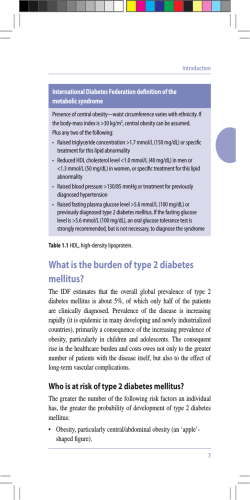
LMC Endocrinology Centres “Doctor, why is my sugar ENDOCRINOLOGY
CLINICAL PRACTICE UPDATE in ENDOCRINOLOGY LMC Endocrinology Centres & DIABETES VOLUME 02 - ISSUE 04 EDITOR RONALD GOLDENBERG MD, FRCPC, FACE LMC “Doctor, why is my sugar just like a bouncing ball” EXECUTIVE DIRECTOR RONNIE ARONSON MD, FRCPC, FACE RONALD GOLDENBERG MD, FRCPC, FACE HASNAIN KHANDWALA MD, FRCPC KIMBERLY MAH-POY MD, FRCPC GLORIA RAMBALDINI MD, FRCPC SAMANTHA SANDLER MD, FRCPC ROBERT SCHLOSSER MD, FRCPC WILLIAM SINGER MB, FRCPC, FACP GEORGE STEINER MD, FRCPC DENNY K.Y. TRINH MD, FRCPC YAW TWUM-BARIMA MD, FRCPC NINA WINE MD, FRCPC LMC A few weeks ago, a patient of mine with longstanding, insulinrequiring type 2 diabetes arrived in the clinic in a state of distress. Up until one week prior to her Ronald Goldenberg, visit, premeal glucose MD, FRCPC, FACE levels had consistently been in the 4 to 8 mmol/L range. Her distress was triggered by monitored glucose levels over the past week bouncing between 7.2 to 14.5, which she had recorded in a logbook. When I scrolled through the memory in her glucose meter, the actual glucose values were ranging from 72 to 145, and she had been adding in the decimal point in her logbook, assuming the decimal display in her meter had malfunctioned. In actual fact, her meter had been inadvertently switched over from SI units to conventional units. Therefore, the sugar levels were ranging from 72 to 145 mg/dl. Converting to SI units indicated readings in the 4 to 8 mmol/L range. After switching the meter back to SI units, I reassured her and arranged follow-up. Our patients with diabetes will often encounter unexplained glucose fluctuations. being misled by a glucose meter error. Our patients with diabetes will often encounter unexplained glucose fluctuations. In this issue of Clinical Practice Update, Amberley Fischer discusses the problem of glycemic variability, and provides us with a practical checklist to help troubleshoot this common clinical problem. The next time your patient says, “Doctor, why is my sugar just like a bouncing ball”, you can refer to the checklist to help you provide the answer. The clinical scenario described is a rare example of one reason for “glycemic variability.” In this case, the patient was from the Endocrinology & Diabetes Specialists of the LMC Endocrinology Centres The opinions expressed in this paper are those of the authors and do not necessarily reflect the opinions of LMC Endocrinology Centres or the editorial board of Clinical Practice Update. Glycemic Variability in Diabetes: A Practical Solution to the “Bouncing Glucose” It is well appreciated by health care providers that tight glycemic control, typically reflected by a near-normal A1C, will help prevent long-term diabetes complications. The DCCT (Diabetes Amberley Fischer, RN, BScN Control and Complications Trial) and UKPDS (United Kingdom Prospective Diabetes Study) demonstrated that achieving A1C levels below 7% will prevent or delay diabetes complications. However, glucose levels are not stagnant in our patients with diabetes - rather, levels range from hypoglycemia to significant hyperglycemia. This “glycemic variability” can be disruptive to a patient's day-to day life, and may also contribute to increased diabetes complications. In fact, the DCCT demonstrated that for any given A1C level, intensively treated patients had less retinopathy than conventionally treated patients. All of us caring for individuals with diabetes have seen patients with wide and unexplained swings in glucose. In these situations, health care providers must look beyond the A1C level to try to determine what factors contribute to glycemic variability. …fluctuating blood glucose levels can be frustrating for patients in their effort to achieve good glycemic control. From a clinical perspective, it can be difficult to determine the cause of variable blood glucose levels. Besides contributing to the development of complications, fluctuating blood glucose levels can be frustrating for patients in their effort to achieve good glycemic control. To help patients achieve smoother glycemic control, it is necessary to address the factors that cause glucose fluctuations. Some general subjects to discuss with the patient include the following: Insulin/Medications (e.g., timing of injections, dosing, injection sites) Diet (e.g., knowledge of carbohydrate counting) Exercise (e.g., appropriate insulin adjustments) Blood Glucose Monitoring (e.g., calibration of meter, technique) Stress (e.g., hormonal changes or illness) Attached is a practical checklist with the above factors to consider when a patient tells you “my blood sugars are all over the map.” The checklist will stimulate the healthcare provider to think about the various issues contributing to the swings in glucose. Typically, by using a logical, problem-solving approach, the cause of glycemic variability can be discovered. By pinpointing one or more factors related to glycemic variability, health care providers may be able to aid their patients in achieving tighter and smoother glycemic control, thereby preventing complications and improving their quality of life. 1. Brownlee M, Hirsch IB. Glycemic variability: a haemoglobin A1cindependent risk factor for diabetic complications. JAMA 2006; 295:1707-1708 2. Canadian Diabetes Association 2003 Clinical Practice Guidelines for the Prevention and Management of Diabetes in Canada. Can J Diabetes. 2003;27(Suppl2): S27-S31 available on the web at www.clinicalpracticeupdate.com <http://www.clinicalpracticeupdate.com> 2 Supported by an educational grant from members of the pharmaceutical industry
© Copyright 2026















